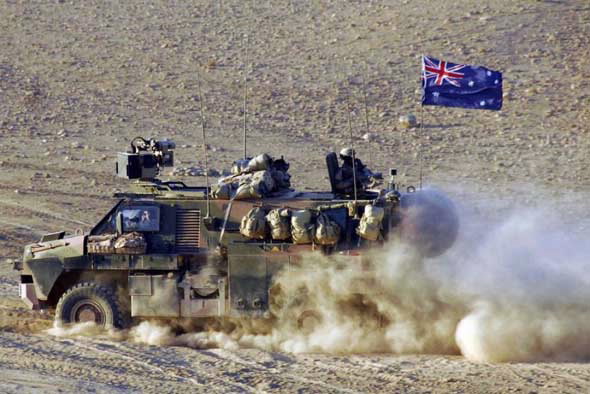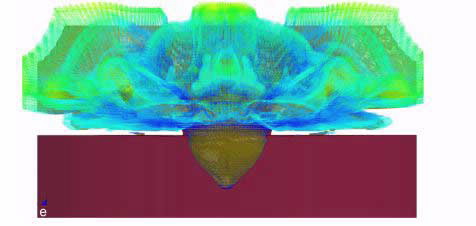Although more than half Michael Saleh’s modelling of advanced structural materials is classified or in-confidence, his contributions to conferences, papers and, most recently, a book chapter, in the public domain have earned him a series of distinguished awards.
Most recently he received an Early Career Award in Nuclear Science and Technology from ANSTO, where he has worked since 2009 on the structural analysis of materials in extreme environments using computational methods. Saleh investigates high strain rate material deformation and failure modelling for applications at ANSTO and external partners.
Using powerful computational techniques known as Finite Element Analysis, (FEA), Saleh is able to mathematically model and numerically solve very complex structural, fluid and multi-physics problems in a virtual environment.
“It gives us a good understanding of the properties of a material and its behaviour under specific conditions,” said Saleh.
 |
| The Bushmaster vehicle used by the Australian Defence Forces in Afghanistan was made with high performance materials |
Saleh has used the approach in a close, highly productive association with the Defence Materials Technology Centre (DMTC) and industry partner Thales Australia over seven years—collaborating on the development of high performance armour materials for use in land platforms.
“Although they have substantial expertise in defence science and engineering, our collaboration brought to DMTC the rapid development of useful modelling capabilities,” said Saleh.
Numerical techniques can capture the behaviour of a system in silico (on a computer), thereby reducing the need for costly and complex experiments.
“We are concerned with making vehicles safer for members of the Australian Defence Forces by studying the potential impacts of blasts from improvised explosive devices (IEDs), land mines and ballistic impacts from firearms,” explained Saleh.
Using numerical constitutive models, he is able to capture and predict the behaviour of the multiple components of an event, such as a blast and ascertain the effects of the blast on the vehicle and its occupants using Hybrid car crash dummies to look at various injury criteria.
“What we look at is structures that are exposed to very large pressures in a very short period of time. How is that event going to affect structures?” said Saleh.
Saleh is part of a small group of individuals in Australia who do this type of complex blast and ballistic modelling and is considered the leading modeller for DMTC.
He has investigated soil mechanics, metallic armour, multi-layer armour and cellular metallic foams for blast absorption using modelling and simulation. Defence contractor Thales Australia has used the tools in the assessment of the Bushmaster (pictured above)and Hawkei protected mobility vehicles.
In addition to three awards from DMTC, Saleh was part of a joint team that received a national Eureka Prize in 2013 for ‘Outstanding Science in Safeguarding Australia’ for the Armour Applications Program of DMTC—the program was established to look at ways to reduce the weight and improve the mobility of land platforms while providing superior protection to Australian Defence Forces. The award recognised the contribution of DMTC, ANSTO, Thales Australia, Bluescope Steel, University of Wollongong, Bisalloy Steels, University of Melbourne, DSTO and Swinburne University of Technology.
Although there is existing software, Saleh develops new material models and algorithms for Smoothed Particle Hydrodynamic (SPH), a computational method to simulate flow and Arbitrary Lagrangian-Eulerian (ALE), a technique for engineering simulations.
“A lot of effort goes into the material parameters because the models are just a blank slate, whether it’s research into parameters or experiments to devise parameters, or writing sub routines.”
Using high performance computing clusters at ANSTO and desktop computers, Saleh requires significant computing power for the modelling and simulations, which are becoming increasingly important.
“It’s big data and big data needs to be visualised through a simulation because it enables you to see where you are on the spectrum of results,”
Saleh’s latest paper in Computers and Structures, co-authored with Lyndon Edwards, head of the Institute of Materials Engineering at ANSTO, tests a modelling methodology for evaluating soil and fluid structures that interact in a blast. The loads associated with an air blast from an IED are complicated by the soil medium in which the blast occurs.
Soil liquefaction and cratering create a focusing effect in addition to the complex, explosive chemical reactions. Sediment or ejecta is also carried along with explosive products in the blast, which constitutes a significant threat of injury and damage.
 |
| Fluid velocity vector plot at t=7.1 microseconds (MAT_FHWA model) |
Saleh evaluated and determined that the numerical methodology ALE was very representative of physical phenomena occurring in a blast event. They also tested a continuum model for critical analysis of soil developed by the US Federal Highway Administration, FHWA. The methodology captured important features, such as soil porosity, moisture content, pore pressure evaluation and the stable fluid transport mechanism that contributed to an accurate analysis of the blast event
“Density and moisture content were critical parameters but also the softening behaviour of the soil because of the development of pore pressure,” said Saleh. Accurate measurement of the cohesion and friction angle also contributed significantly to the success of the simulation.
Saleh, Edwards, along with Dr Dinesh Shanmugam and Richard Smith from Thales Australia, expanded on the blast modelling by incorporating a generic vehicle hull to evaluate the soil interaction in a blast event and its potential impact on the occupants of the vehicle. They presented the study at the International Symposium on Ballistics in the USA in 2014.
In previous computational modelling research in association with DMTC published in the International Journal of Impact Engineering, Saleh and collaborators investigated the performance of single and multi-layered targets used in armoured shields against projectiles and predicted the ballistic behaviour of the materials.
The purpose of the research was the need to optimise protective structures for civil and military personnel. The research predictions concluded that double layered mixed plates, with a combination of aluminium alloys and steels, used in many armoured vehicles, performed better than steel alone.
With a background in aerospace engineering and structures from RMIT University, Saleh joined ANSTO as a computer modeller but quickly demonstrated his versatility and enthusiasm to develop public and private sector partnerships.
Saleh is also involved in mechanical testing and neutron diffraction experiments for validation. Many projects are multidisciplinary and utilise ANSTO’s state of the art facilities and instruments, with particular emphasis on two neutron beam lines, Kowari and Dingo, which are used for stress evaluation, texture measurements and neutron tomography.
“Ideally you need validation, whether it comes from analytical models or an experiment, computer modelling greatly complements experiments” said Saleh.
Saleh has contributed a chapter on blast and ballistic modelling for a book on the science of armour materials to be published by Elsevier Woodhead later this year, while he continues to submit research papers and finish a PhD in Material Science at the University of New South Wales Australia on multiscale modelling of radiation damage in nuclear materials.
The collaboration with DMTC will continue for three more years.
Published: 20/01/2016


